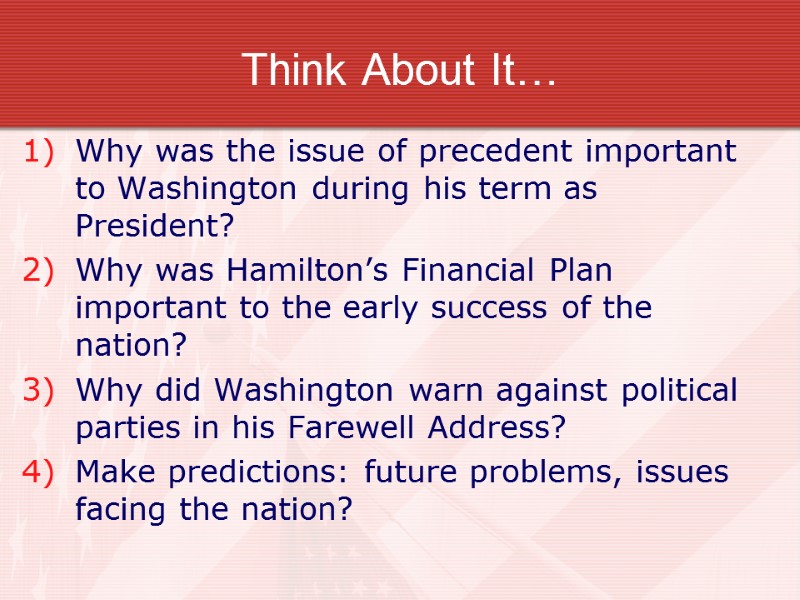The Early Republic (1789-1800) “’tis the event which


The Early Republic (1789-1800) “’tis the event which I have long dreaded” -George Washington on his Presidential election By: Shauntel Jones, Joey Tardiff ,Andrez Garcia , James Alty

The Bill of Rights Drafted by James Madison Relied heavily on Virginia Declaration of Rights (George Mason) 10 amendments specifying rights of the people Went into effect 1791

Alexander Hamilton Co-author- The Federalist Papers Industrial vision of America’s future Admired Britain’s strong central government and industrial strength Ambitious, hardworking Appointed first Secretary of the Treasury by GW Ordered to solve nation’s financial problems Alexander Hamilton

Hamilton’s Financial Plan 3 Parts: Report on Public Credit- Federal government assumes all state debts Report on Banking- Asked Congress to create a Bank of the U.S. to issue currency, manage debt, etc. Report on Manufactures- pass a protective tariff to stimulate domestic manufacturing

Opposition to Plan Southerners felt plan favored Northern states Debate over meaning of Constitution “strict” vs “loose” interpretation Was bank “necessary and proper” for the nation? Thomas Jefferson James Madison

Bank of the United States Most controversial part of Hamilton’s plan Led to formation of America’s modern political parties Federalists (pro-Bank), Democratic-Republicans (anti-Bank) 1791- Washington sides with Hamilton, Bank is created (BUS) First Bank of the US- Philadelphia

Early Political Parties Hamilton and Federalists Strong central gov’t Rule by wealthy, educated Industrial vision loose interpretation Pro-England Protective tariffs, BUS Jefferson and the Republicans Strong state govts Rule by the common man Agrarian vision strict interpretation Pro-France Anti- tariffs, BUS

Early Political Parties (con’t) Federalists Supported by artisans, merchants, manufacturers, bankers North, urban cities Basis for modern Republican party Democratic-Republicans Supported by farmers South, western frontier Basis for modern Democratic Party

Foreign Policy Under Washington Revolution in France divides America 1793- Washington’s Neutrality Proclamation (England vs France) Impressments of American ships Jay’s Treaty (1794) Pinckney’s Treaty (1795) Chaos in France

Western Expansion 1780s-90s: area between Appalachians and Miss. River settled rapidly Led to conflicts with Natives (Battle of Fallen Timbers) in Northwest Territory Treaty of Greenville (1795) Battle of Fallen Timbers (1794): American troops vs native confederation

Think About It… Why was the issue of precedent important to Washington during his term as President? Why was Hamilton’s Financial Plan important to the early success of the nation? Why did Washington warn against political parties in his Farewell Address? Make predictions: future problems, issues facing the nation?
11198-the_early_republic.ppt
- Количество слайдов: 11

